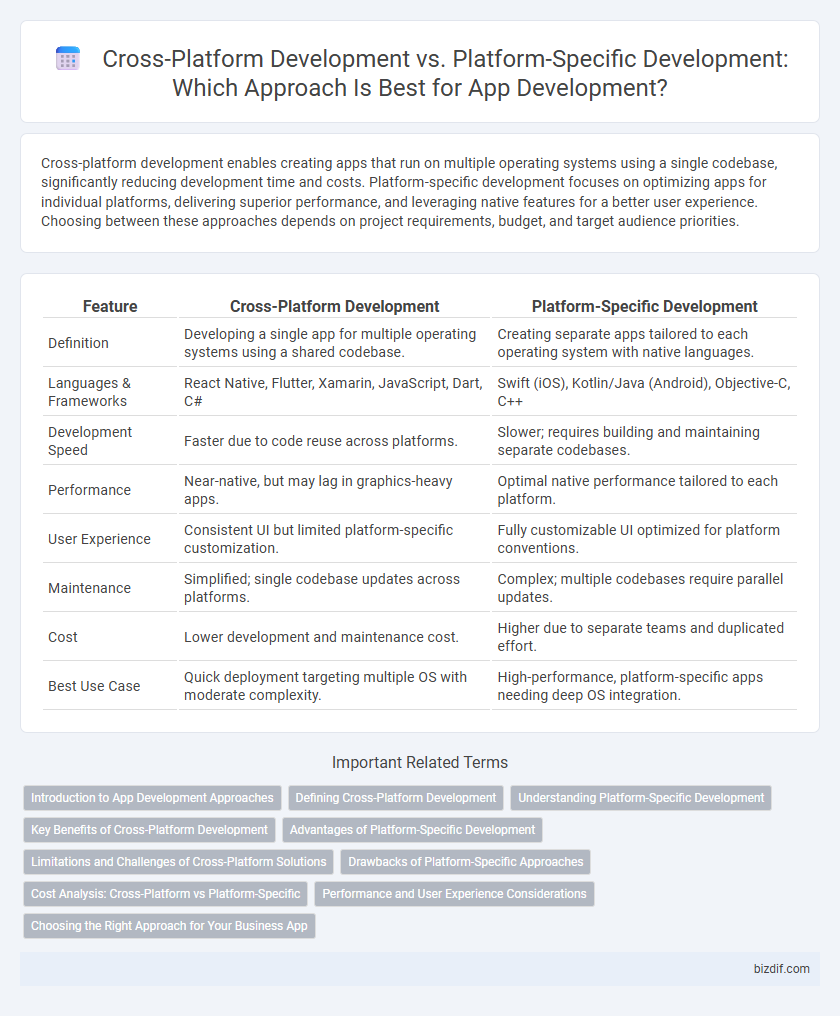Cross-platform development enables creating apps that run on multiple operating systems using a single codebase, significantly reducing development time and costs. Platform-specific development focuses on optimizing apps for individual platforms, delivering superior performance, and leveraging native features for a better user experience. Choosing between these approaches depends on project requirements, budget, and target audience priorities.
Table of Comparison
| Feature | Cross-Platform Development | Platform-Specific Development |
|---|---|---|
| Definition | Developing a single app for multiple operating systems using a shared codebase. | Creating separate apps tailored to each operating system with native languages. |
| Languages & Frameworks | React Native, Flutter, Xamarin, JavaScript, Dart, C# | Swift (iOS), Kotlin/Java (Android), Objective-C, C++ |
| Development Speed | Faster due to code reuse across platforms. | Slower; requires building and maintaining separate codebases. |
| Performance | Near-native, but may lag in graphics-heavy apps. | Optimal native performance tailored to each platform. |
| User Experience | Consistent UI but limited platform-specific customization. | Fully customizable UI optimized for platform conventions. |
| Maintenance | Simplified; single codebase updates across platforms. | Complex; multiple codebases require parallel updates. |
| Cost | Lower development and maintenance cost. | Higher due to separate teams and duplicated effort. |
| Best Use Case | Quick deployment targeting multiple OS with moderate complexity. | High-performance, platform-specific apps needing deep OS integration. |
Introduction to App Development Approaches
Cross-platform development enables building mobile applications that run on multiple operating systems like iOS and Android using a single codebase, saving time and resources. Platform-specific development involves creating apps tailored to a specific OS, maximizing performance and user experience by leveraging native APIs and tools. Choosing between these approaches depends on project requirements, budget, and desired app functionality.
Defining Cross-Platform Development
Cross-platform development enables the creation of applications that run seamlessly on multiple operating systems using a single codebase, significantly reducing development time and costs. Frameworks like React Native, Flutter, and Xamarin provide tools and libraries to build versatile apps compatible with iOS, Android, and web platforms. This approach enhances consistency in user experience while simplifying maintenance and updates across diverse environments.
Understanding Platform-Specific Development
Platform-specific development involves creating apps tailored specifically for one operating system like iOS or Android, utilizing native languages such as Swift or Kotlin to maximize performance and access device-specific features. This approach ensures optimal user experience by leveraging platform-optimized UI components and native APIs. Developers benefit from enhanced app stability, faster execution, and seamless integration with the device ecosystem, which is critical for performance-intensive applications.
Key Benefits of Cross-Platform Development
Cross-platform development enables the creation of applications that run seamlessly on multiple operating systems like iOS and Android using a single codebase, significantly reducing development time and costs. It enhances code reusability and simplifies maintenance by allowing updates and bug fixes to be implemented across all platforms simultaneously. This approach also broadens market reach by ensuring consistent user experiences on diverse devices and platforms.
Advantages of Platform-Specific Development
Platform-specific development offers superior performance and seamless integration by leveraging native APIs and hardware capabilities tailored to each operating system. It ensures enhanced user experience through customized interfaces and optimized responsiveness that align perfectly with platform guidelines. Developers can access exclusive platform features and receive direct support from platform vendors, resulting in higher-quality, reliable applications.
Limitations and Challenges of Cross-Platform Solutions
Cross-platform development faces limitations such as reduced access to native device features and potential performance bottlenecks compared to platform-specific development. Compatibility issues arise due to discrepancies in operating system updates, leading to inconsistent user experiences across devices. Debugging and maintenance complexity increases as developers must address platform-specific bugs within a unified codebase.
Drawbacks of Platform-Specific Approaches
Platform-specific development often leads to higher costs and extended timelines due to the need for separate codebases tailored to each operating system, such as iOS and Android. This approach limits code reusability and increases maintenance complexity, as updates and bug fixes must be implemented individually for each platform. Additionally, platform-specific apps may struggle with inconsistent user experiences and delayed feature rollouts compared to cross-platform alternatives.
Cost Analysis: Cross-Platform vs Platform-Specific
Cross-platform development significantly reduces costs by allowing a single codebase to target multiple operating systems such as iOS and Android, cutting down on both development time and maintenance expenses. Platform-specific development, while potentially offering better performance and tailored user experiences, generally incurs higher costs due to separate coding, testing, and updates for each platform. Businesses must weigh the initial investment against long-term costs, considering factors like project complexity, target audience, and required app performance.
Performance and User Experience Considerations
Cross-platform development enables code reuse across multiple operating systems, enhancing development efficiency but may introduce performance overhead due to abstraction layers. Platform-specific development allows deep integration with native APIs, resulting in optimized performance and a smoother user experience tailored to the device's capabilities. Choosing between these approaches requires balancing development speed with the demand for high responsiveness and seamless interface interactions.
Choosing the Right Approach for Your Business App
Cross-platform development enables businesses to build a single app that runs on multiple operating systems, reducing time-to-market and development costs while maintaining consistent user experience. Platform-specific development offers tailored performance and functionality by leveraging native APIs and tools for iOS or Android, ideal for apps requiring high customization or advanced device features. Selecting the right approach depends on factors like target audience, budget, required features, and maintenance resources, ensuring the app aligns with business goals and user expectations.
Cross-Platform Development vs Platform-Specific Development Infographic

 bizdif.com
bizdif.com